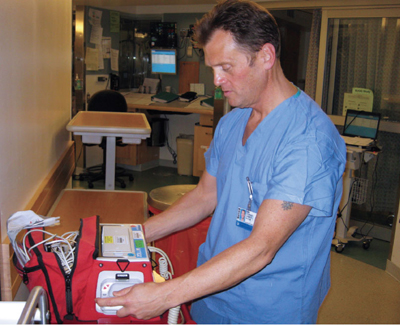Rapid Response Teams Enhance Care

The MICU’s Donald Grimes, RN, a member of the Rapid Response team, checks a defibrillator. |
When a non-ICU patient’s condition deteriorates, any member of the care team can identify the need for a rapid response. The rapid response system (RRS) brings a team of multidisciplinary clinicians to the bedside, within 10 minutes, to deliver immediate care and to initiate interventions to prevent further deterioration.
At BWH, recent results indicate that the increased number of rapid response activations may be lowering overall cardiac and intermediate/step down unit arrest rates.
“Sometimes you may think that you have all of the care team members at the bedside you need, but you might be missing a respiratory therapist or the expertise that a MICU nurse brings, for example,” said Marsha Milone, MSN/Ed, RN, nursing director of the Hematology /Oncology and Bone Marrow Transplant Unit. “One of the most valuable resources you can have is a nurse from the MICU who can quickly assess what’s going on with the patient and, if the patient needs it, facilitate a transfer to the MICU.”
The rapid response team includes the patient’s primary team physician, physician assistant, respiratory therapist and a critical care nurse. In addition to the clinicians responding to the bedside, nursing directors and off-shift nurse administrators are alerted to RRS events, and can assist to smooth transfer to an ICU as the patient’s condition necessitates.
“Calling the rapid response team reflects the fact that a patient needs a multidisciplinary care team at the bedside immediately to perform a multidisciplinary assessment,” said Karen Griswold, MBA, RN, senior consultant for Patient Safety. “This is another way that we ensure our patients receive the best care, especially when they unexpectedly decline.”
The RRS rolled out at BWH in 2009. After a downward trend in staff activating the response team, a series of focus groups were held in 2011. Nursing directors, clinical staff nurses, physician assistants, house staff and respiratory therapists attended to share feedback on what was working well and areas for improvement. The focus groups also reminded staff about the RRS.
“We learned that people needed a reminder of who could and should activate it,” Griswold said.
“All care providers at the bedside should feel empowered to make the decision to call the rapid response team,” added Mary Lou Moore, MSN, RN, associate chief nurse.
After the focus groups, there was an immediate bump in activations of the rapid response team.
“The focus groups helped to clarify that anyone on the care team can call,” said Griswold. “This may be one of the factors contributing to the increased number of rapid response activations, which we believe may be lowering our overall cardiac arrest rates and our intermediate/step-down unit arrest rates.”
Another trend is an increase in the overall survival to discharged patients after cardiac arrest. Rapid response is one factor that is contributing to this trend.
Milone advised nurses to activate the rapid response team as soon as they feel it is necessary. “Don’t hesitate,” she said. “It’s such a great resource to get your patients to where they need to be. That may still be on your unit, but you’ll have a better immediate plan because of the rapid response team.”
Activation of the Rapid Response System:
Once a staff member determines there has been a change in a patient’s condition that meets the Early Warning Criteria, the staff member should call the Stat Line at 2-6555 and ask to page out a Rapid Response for the appropriate building, floor, pod, room number and the patient’s name.

From left, members of the Rapid Response team include Gary Zina, RN, Suzanne Lieberman, RN, and Paul Sedgwick, RN. |